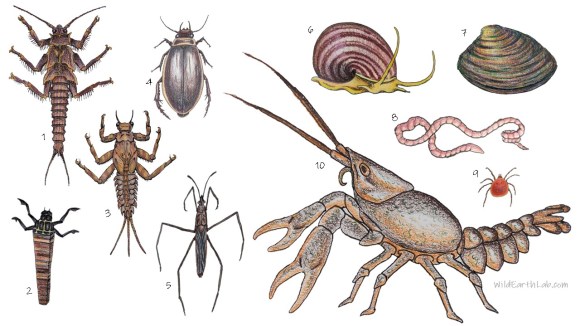What is an aquatic macroinvertebrate? Perhaps you are studying aquatic ecology or bioindicators and came across this term. In this case, the name provides us with a few hints… Let’s break it down:
Aquatic – lives in or on water.
Macro – large enough to be seen by the naked eye.
Invertebrate – animal with no backbone.
So… an aquatic macroinvertebrate is an animal with no backbone that lives in or on water and is big enough that you can see it with your naked eye. This includes animals like aquatic insects, other aquatic arthropods (e.g., crayfish, water mites), aquatic mollusks (e.g., mussels), aquatic worms, and more.

Why do aquatic macroinvertebrates matter?
Aquatic food webs
Now that you know what aquatic macroinvertebrates are, your next question is likely… “Why should I care about them?” True, these tiny critters may seem unremarkable, or even “icky”. However, these creatures have important roles in aquatic ecosystems. Aquatic macroinvertebrates are key members of aquatic food webs. Many macroinvertebrates help recycle nutrients back into the food web by consuming detritus (decaying matter) that settles to the bottom of the water. All those nutrients would be lost if the aquatic macroinvertebrates were not around to use them!
Macroinvertebrates are a key food source for other aquatic animals. Many fish, birds, and amphibians eat macroinvertebrates. If the macroinvertebrate community is not thriving, all the animals that rely on macroinvertebrates as food will feel the impact. Problems for the macroinvertebrate community are problems for the whole ecosystem!

Use as bioindicators
Also, certain macroinvertebrates are very sensitive to poor water quality and other human impacts. For this reason, scientists consider some macroinvertebrate species to be excellent bioindicators. A bioindicator is a type of organism whose wellbeing relates closely to ecological conditions and is studied by scientists
Scientists sometimes struggle to find ways to quantitatively measure overall ecosystem health. Ecosystem health depends on many factors (e.g., temperature, nutrient cycling, water chemistry). How do we know if an ecosystem is healthy? How can we tell if our actions are improving or harming an ecosystem?
To help answer these questions, scientists created indexes of biological integrity. Indexes basically allow us to give an ecosystem a score for its overall health, based on its community. Indexes use things like species richness to represent ecosystem health. A popular index for aquatic ecosystem health looks at EPT richness – that is the number of different types of Ephemeroptera, Plecoptera, and Trichoptera (mayflies, stoneflies, and caddisflies).

Study macroinvertebrates in your classroom!
If you enjoyed this post, I know you will love my Aquatic Ecology: Macroinvertebrates Unit. It includes posters, lab activities, readings, worksheets – everything you need for an awesome aquatic macroinvertebrates unit with your class! Find it in my shop!
Your curriculum purchase supports my blog and helps me create more educational content for the environmental sciences.
Thank you for your support!
More from Wild Earth Lab:
Are you interested in reading more posts like this? Subscribe or follow Wild Earth Lab using the links below!
Subscribe to this blog
References and Further Reading
- Merritt, R. W., Cummins, K. W., & Berg, M. B. (2008). Aquatic insects of North America (4th edition). Kendall Hunt, Dubuque.
- Pyron, M. (2010) Characterizing Communities. Nature Education Knowledge 3(10):39. Available: https://www.nature.com/scitable/knowledge/library/characterizing-communities-13241173/
- Stumpf, S., Valentine-Darby, P., & Gwilliam, E. (2015). Aquatic Macroinvertebrates – Habitat and Life History. NPS Inventory and Monitoring Program, 2009. Available: https://www.nps.gov/articles/aquatic-macroinvertebrates-habitat.htm
- UNH Center for Freshwater Biology (2013). An image-based key to stream insects. Department of Biological Sciences, University of New Hampshire, Durham, NH 03824 USA. Available: http://cfb.unh.edu/StreamKey/html/index.html
- Ward, J. V., Kondratieff, B. C., & Zuellig, R. E. (2002). Mountain stream insects of Colorado (2nd edition). University Press of Colorado.




